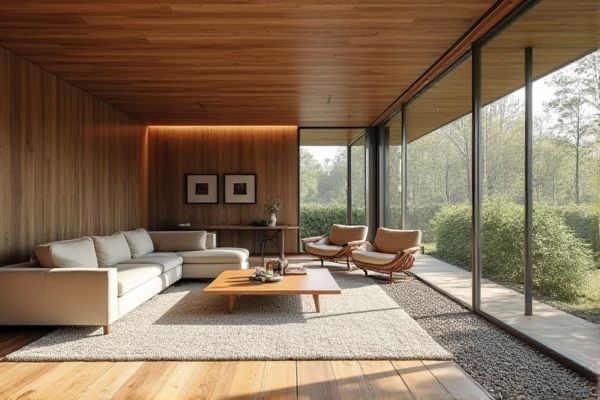
Gravel flooring offers a natural, durable, and low-maintenance surface ideal for outdoor spaces, while wooden tiles provide warmth, aesthetic appeal, and a more refined look suitable for indoor areas. Discover the key differences to determine which option best suits Your design needs by reading the rest of the article.
Table of Comparison
| Feature | Gravel Flooring | Wooden Tiles |
|---|---|---|
| Material | Natural stone pebbles | Engineered or solid wood |
| Durability | Highly durable, weather-resistant | Moderate, prone to scratches and water damage |
| Maintenance | Low, occasional raking and debris removal | Medium, regular cleaning and polishing required |
| Installation | Simple, requires leveling and spreading stones | Complex, needs precise fitting and adhesive |
| Comfort | Hard and uneven surface | Warm and smooth underfoot |
| Cost | Low to moderate | Moderate to high |
| Aesthetic | Natural, rustic look | Elegant, classic wooden finish |
| Suitable Areas | Outdoor patios, garden paths | Indoor rooms, covered spaces |
Introduction to Gravel Flooring and Wooden Tiles
Gravel flooring offers a natural, porous surface ideal for outdoor patios and garden paths, providing excellent drainage and a rustic aesthetic. Wooden tiles create a warm, elegant look perfect for indoor spaces or covered patios, combining durability with the rich texture of wood. Choosing between gravel flooring and wooden tiles depends on your specific use case, maintenance preferences, and desired ambiance.
Key Differences Between Gravel and Wooden Tile Flooring
Gravel flooring offers a natural, porous surface ideal for outdoor spaces, providing excellent drainage and a rustic aesthetic, while wooden tiles deliver a smooth, warm finish suited for indoor environments, enhancing comfort and elegance. Gravel is low-maintenance and durable under harsh weather conditions, contrasting with wooden tiles that require regular sealing and protection against moisture to prevent warping or damage. Cost-wise, gravel flooring is generally more affordable initially but can be harder to clean, whereas wooden tiles involve higher installation costs but offer easier maintenance and a variety of design options.
Aesthetic Appeal: Natural vs. Engineered Looks
Gravel flooring offers a rustic, natural aesthetic that enhances outdoor spaces with its organic texture and earthy tones, creating a unique, tactile environment. Wooden tiles provide a refined, engineered appearance that mimics natural wood grain but with uniformity and precision, ideal for achieving a polished indoor look. Your choice between these options depends on whether you prefer the raw, natural charm of gravel or the sleek, consistent elegance of wooden tiles.
Installation Process: Gravel vs. Wooden Tiles
Gravel flooring installation involves preparing a compacted base layer followed by spreading and leveling the gravel, allowing for quick drainage and minimal groundwork. Wooden tile installation requires precise subfloor preparation, careful alignment, and secure attachment using adhesives or interlocking systems, ensuring durability and aesthetic consistency. Gravel offers a simpler, cost-effective setup, while wooden tiles demand a more detailed, labor-intensive process with higher installation expertise.
Durability and Longevity Comparison
Gravel flooring offers exceptional durability due to its resistance to cracking, moisture, and heavy foot traffic, making it ideal for outdoor and high-use areas. Wooden tiles, while aesthetically appealing, are more susceptible to scratches, moisture damage, and wear over time, requiring regular maintenance to extend their lifespan. Gravel's low maintenance and weather-resistant properties generally provide greater longevity compared to wooden tiles, which may need periodic refinishing or replacement.
Maintenance and Cleaning Requirements
Gravel flooring demands regular raking and occasional replenishment to maintain its appearance and prevent weed growth, while wooden tiles require sweeping and periodic sealing or polishing to protect against moisture and wear. Gravel is more porous, allowing dirt to settle between stones, making deep cleaning challenging compared to wooden tiles that can be wiped or mopped easily. Wooden tiles generally need less frequent but more specialized maintenance to preserve their finish and prevent warping or cracking.
Cost Analysis: Upfront and Long-term Expenses
Gravel flooring typically offers a lower upfront cost compared to wooden tiles, making it an economical choice for budget-conscious projects. However, wooden tiles, while more expensive initially, provide greater durability and lower maintenance expenses over time, which can reduce long-term costs. The overall expense depends on factors such as installation complexity, expected lifespan, and repair frequency, with wooden tiles often delivering higher value in longevity and aesthetic appeal.
Suitability for Indoor and Outdoor Spaces
Gravel flooring excels in outdoor settings due to its natural drainage capabilities and durability against weather elements, making it ideal for patios, garden paths, and driveways. Wooden tiles offer versatile applications for indoor spaces, providing warmth, aesthetic appeal, and ease of maintenance, while treated varieties can be suitable for covered outdoor areas. Choosing between gravel and wooden tiles depends on environmental exposure, maintenance preferences, and desired ambiance in specific indoor or outdoor zones.
Environmental Impact and Sustainability
Gravel flooring has a lower environmental impact due to its natural, permeable materials that support water drainage and reduce erosion, making it a more sustainable option than wooden tiles. Wooden tiles, while biodegradable, often involve deforestation and require energy-intensive processing, which can contribute to carbon emissions. Choosing gravel flooring for your space enhances sustainability by minimizing resource depletion and promoting eco-friendly site management.
Pros and Cons: Gravel Flooring vs. Wooden Tiles
Gravel flooring offers durability, excellent drainage, and a natural, rustic aesthetic but can be uncomfortable to walk on and challenging to clean, making it less suitable for indoor use. Wooden tiles provide warmth, elegance, and ease of installation with options for various finishes, though they may suffer from moisture damage and require regular maintenance to prevent warping or scratches. Your choice depends on the desired look, maintenance willingness, and the specific functionality of the space.
 homyna.com
homyna.com